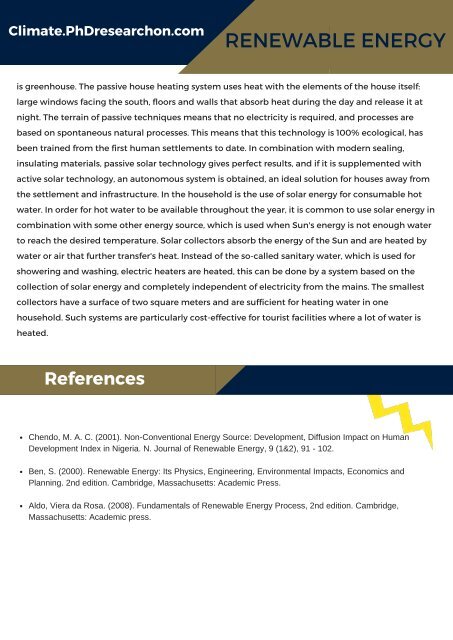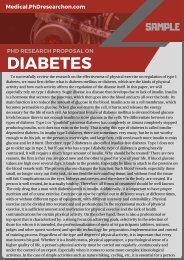PhD Research Thesis on Renewable Energy Sample
Good news! We have prepared for you a new PDF about PhD research thesis, read more http://climate.phdresearchon.com/
Good news! We have prepared for you a new PDF about PhD research thesis, read more http://climate.phdresearchon.com/
Create successful ePaper yourself
Turn your PDF publications into a flip-book with our unique Google optimized e-Paper software.
Climate.<str<strong>on</strong>g>PhD</str<strong>on</strong>g>research<strong>on</strong>.com<br />
SAMPLE<br />
RENEWABLE ENERGY<br />
is greenhouse. The passive house heating system uses heat with the elements of the house itself:<br />
large windows facing the south, floors and walls that absorb heat during the day and release it at<br />
night. The terrain of passive techniques means that no electricity is required, and processes are<br />
based <strong>on</strong> sp<strong>on</strong>taneous natural processes. This means that this technology is 100% ecological, has<br />
been trained from the first human settlements to date. In combinati<strong>on</strong> with modern sealing,<br />
insulating materials, passive solar technology gives perfect results, and if it is supplemented with<br />
active solar technology, an aut<strong>on</strong>omous system is obtained, an ideal soluti<strong>on</strong> for houses away from<br />
the settlement and infrastructure. In the household is the use of solar energy for c<strong>on</strong>sumable hot<br />
water. In order for hot water to be available throughout the year, it is comm<strong>on</strong> to use solar energy in<br />
combinati<strong>on</strong> with some other energy source, which is used when Sun's energy is not enough water<br />
to reach the desired temperature. Solar collectors absorb the energy of the Sun and are heated by<br />
water or air that further transfer's heat. Instead of the so-called sanitary water, which is used for<br />
showering and washing, electric heaters are heated, this can be d<strong>on</strong>e by a system based <strong>on</strong> the<br />
collecti<strong>on</strong> of solar energy and completely independent of electricity from the mains. The smallest<br />
collectors have a surface of two square meters and are sufficient for heating water in <strong>on</strong>e<br />
household. Such systems are particularly cost-effective for tourist facilities where a lot of water is<br />
heated.<br />
References<br />
Chendo, M. A. C. (2001). N<strong>on</strong>-C<strong>on</strong>venti<strong>on</strong>al <strong>Energy</strong> Source: Development, Diffusi<strong>on</strong> Impact <strong>on</strong> Human<br />
Development Index in Nigeria. N. Journal of <strong>Renewable</strong> <strong>Energy</strong>, 9 (1&2), 91 - 102.<br />
Ben, S. (2000). <strong>Renewable</strong> <strong>Energy</strong>: Its Physics, Engineering, Envir<strong>on</strong>mental Impacts, Ec<strong>on</strong>omics and<br />
Planning. 2nd editi<strong>on</strong>. Cambridge, Massachusetts: Academic Press.<br />
Aldo, Viera da Rosa. (2008). Fundamentals of <strong>Renewable</strong> <strong>Energy</strong> Process, 2nd editi<strong>on</strong>. Cambridge,<br />
Massachusetts: Academic press.





